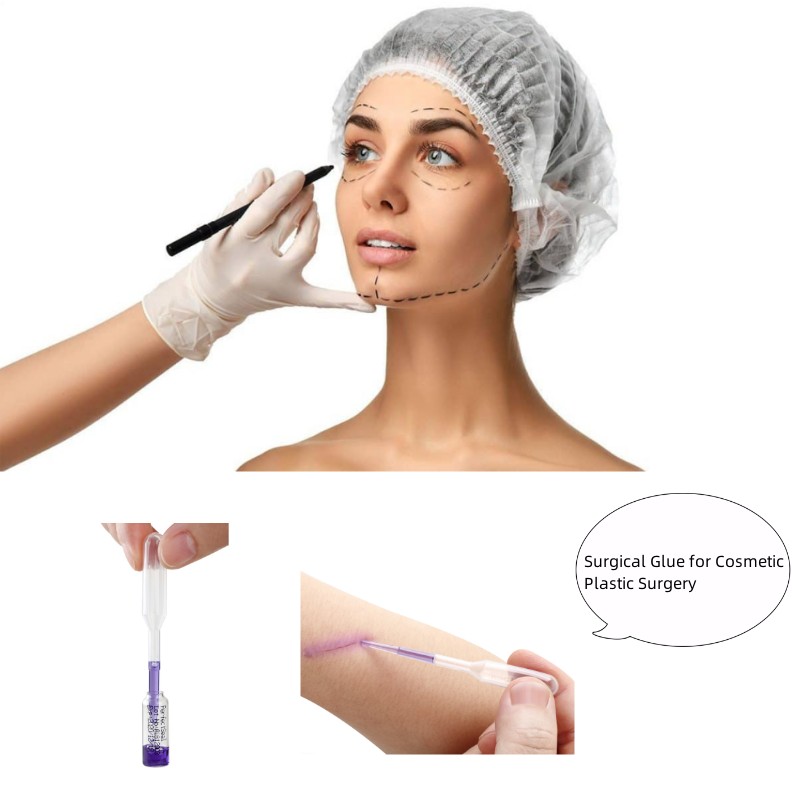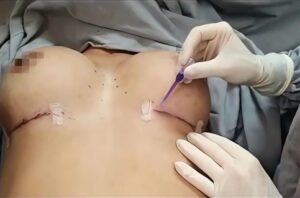In some countries such as the USA, South Korea, Brazil, Germany, Italy, and Greece, cosmetic plastic surgery is highly popular and diverse, with patients undergoing various types of procedures to enhance their appearance. Surgical glue is one tool that surgeons use to improve the outcomes of cosmetic surgery procedures. In this article, we will explore the different types of cosmetic surgery procedures and the role that surgical glue plays in achieving successful outcomes.

Overview of Cosmetic Plastic Surgery Procedures
Cosmetic plastic surgery is a collection of surgical procedures aimed at improving the aesthetic appeal, symmetry, and overall appearance of the patient. Some of the most common types of cosmetic surgery procedures include double eyelid surgery, bags under eyes, arm lift surgery, abdominal plasty, thighplasty, etc. These procedures can improve the appearance of a certain part of the body and help patients to look and feel more confident.
What is double eyelid surgery?
Double eyelid surgery or “Asian blepharoplasty”, is a procedure in which an upper eyelid crease is created, resulting in a larger, more symmetric, almond-shaped eye. The procedure involves making a small incision in the upper eyelid and removing a small amount of skin and fat tissue. The remaining skin is then folded and sutured glued to create a crease.

What are bags under eyes?
Bags under eyes are mild swelling or puffiness under the eyes. They’re common as you age and the tissues around your eyes weaken, including some of the muscles supporting your eyelids. Bags under eyes are usually a cosmetic concern and rarely a sign of a serious condition. At-home remedies, such as cool compresses, can help improve their appearance. For persistent or bothersome under-eye puffiness, eyelid surgery may be an option.

What is arm lift surgery?
An arm lift surgery (Brachioplasty) is a surgery that reshapes the back part of your upper arm, from your arm to your elbow. It removes extra skin and tissue. It makes your upper arm look smoother.
- Reduces excess sagging skin that droops downward
- Tightens and smoothes the underlying supportive tissue that defines the shape of the upper arm
- Reduces localized pockets of fat in the upper arm region
- Fluctuations in weight, growing older and heredity can cause your upper arms to have a drooping, sagging appearance. This is a condition that cannot be corrected through exercise.
During this surgery, your surgeon will make a cut on the inside or back of your arm. He or she will remove extra folds of skin and fat. Your surgeon will then sew and glue the tissue that is left back together. This creates a smoother contour.

What is abdominoplasty?
Abdominoplasty also known as a tummy tuck, is a cosmetic surgical procedure to improve the shape and appearance of the abdomen.
During abdominoplasty, excess skin and fat are removed from the abdomen. Connective tissue in the abdomen (fascia) usually is tightened with sutures and surgical skin glue as well. The remaining skin is then repositioned to resulting in a flatter and firmer abdominal profile.

What is thighplasty?
A thighplasty, also known as a thigh lift, is a cosmetic surgical procedure. This procedure reshapes the thigh by reducing excess skin and fat, so that they look slim and in proportion with the rest of the body. It also relieves pain and irritation that occurs when your thighs continuously rub against each other.
To perform the thigh lift, incisions may vary depending on technique, but will typically start in the groin. Excess fat and skin are removed, and then the incision is closed.

Applications of Surgical Glue in Cosmetic Plastic Surgery
Surgical glue, also known as surgical tissue adhesive or fibrin glue, that forms a strong bond across apposed wound edges, allowing normal healing to occur below. It is a specialized medical adhesive used by surgeons to close wounds during procedures. This glue can be used in cosmetic surgery to improve outcomes and reduce the risk of post-operative complications. Depending on the type of cosmetic surgery procedure, surgeons may use surgical glue in different ways.
For instance, in double eyelid surgery, surgical glue is used to fixate the newly created crease and prevent the eye from losing its shape. This is a relatively safe technique that can be easily performed. It provides the same closure time and aesthetic results as conventional suturing techniques. Additional benefits potentially include save time during wound repair, to provide a flexible water-resistant protective coating and to eliminate the need for suture removal.
In other procedures, such as arm lift surgery, abdominoplasty, and thigh lift surgery, surgical glue is used in conjunction with sutures to close the incision and prevent excessive bleeding.
In eye bag surgery, surgical glue is used to adhere the incision to the underlying tissue, reducing post-operative swelling and improving the healing process.
Benefits of Surgical Glue
- Maximum bonding strength at two and one-half minutes
- Equivalent in strength to healed tissue at seven days post repair
- Can be applied using only a topical anesthetic, no needles
- Faster repair time
- Reduced scarring
- Better acceptance by patients
- Water-resistant covering, reduced risk of infection
- Does not require removal of sutures
Risks of Surgical Glue
The possibility of the glue causing skin irritation or inducing an allergic reaction.
Notice
PerfectSeal is a professional medical adhesive manufacturer, self-synthesized surgical glue raw materials(n-butyl cyanoacrylate and 2-octyl cyanoacrylate) to ensure latex free.
The difference between N-butyl cyanoacrylate and 2-octyl cyanoacrylate
Contraindications to Use of Surgical Skin Adhesives
- Jagged or stellate lacerations
- Bites, punctures or crush wounds
- Contaminated wounds
- Mucosal surfaces
- Axillae and perineum (high-moisture areas)
- Hands, feet and joints (unless kept dry and immobilized)
FAQ
What wounds are suitable for closure with skin adhesives?
Lacerations on the face, torso and extremities that are not greater than 4 inches in length, not contaminated or infected and have skin edges that are not under tension.
May I use PerfectSeal medical skin adhesive in wounds deeper than 1/16 of inch?
No, but deeper wounds may be closed with subcutaneous sutures first. This will achieve the needed strength to keep the wound closed while healing and finishing the skin surface with PerfecrSeal Medical Adhesive will reduce scarring.
Can I use PerfectSeal Medical Surgical Adhesives on a joint?
Yes, if you immobilize the joint with a splint, or tongue depressor.
What procedure should I use when I want to apply a medical adhesive near the eye?
PerfectSeal Medical Adhesive is especially valuable in treating wounds near the eyes because it the precision applicator/tip, but there are a few added safeguards to consider.
Place the patient in a horizontal position.
Use a ridge of petroleum jelly between the wound and eye. This will make it impossible for the skin adhesive to travel, or follow a crease line into the eye. Do not put petroleum jelly on any of the area next to the wound being treated, as this will prevent adhesion.
Is PerfectSeal Medical Adhesive the same as Krazy Glue or Super Glue?
No, PerfectSeal medical adhesive is n-butyl cyanoacrylate or n-octyl cyanoacrylate. These are no-toxic and sterile. But Krazy Glue or Super Glue are either ethyl, or methyl cyanoacrylates. These are toxic, non-sterile products, not approved for medical use and will burn human skin when applied.
Why does surgical glue harden when applied to skin?
All medical adhesives in the cyanoacrylate family harden on contact with moisture. An advantage of PerfectSeal surgical skin glue is that it hardens when it comes in contact with skin moisture. In its ampoule applicator, the compound is in monomeric form, when it comes into contact with anions, especially hydroxyl ions (in the presence of water) it polymerizes.
What are the most essential elements to remember when using a medical adhesive?
- Sanitize the wound according to standard protocol.
- Approximate edges when wound is dry.
- Gently squeeze drops or a thin layer of skin adhesive beside the wound.
- Pull the adhesive over the wound with the applicator, as if building a bridge over the wound. Never put the adhesive in the wound. Hold for 15 seconds; apply a second coat.
Why should I put on thin layers instead of one thicker coat?
For optimum strength/performance place 2 to 3 thin overlapping layers for a stronger finished product. The edge of each new layer should overlap the previous layer. A thick coat may cause a slight burning sensation. A thick coat may also cause the adhesive bond to break down sooner.
What is the most common physician error when applying medical adhesive?
There are two common errors:
The adhesive is placed in the wound, instead of beside it.
The adhesive is applied too thickly which may cause a slight burning sensation and weakens the bond.
What is the shelf life of PerfectSeal Medical Adhesive?
The shelf life of PerfectSeal Medical Adhesive is guaranteed for two years from the date of manufacture. Of course, proper storage conditions ensure shelf life. The ideal storage temperature is 72˚F/22˚C., or lower.





